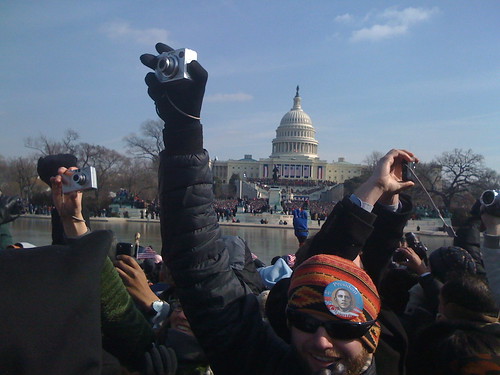On what better day than Election Day to follow up on that tidbit I dropped a couple weeks ago regarding a consultation about then-candidate Barack Obama’s dry-erase boards, a recent acquisition by the National Museum of African American History and Culture? These artifacts, along with archival material and other realia (in archives terms: a man-made three-dimensional object) were acquired by curators to preserve tangible material evidence of a history-making office and event. At first, when I was asked to help figure out how to preserve it, I started laughing, given the challenges the objects presented. But as soon as I started thinking, I began to discuss options in what became an interesting round-robin of emails between myself, the curators, and other conservators.

Since the immediate plan for the objects was for them to be moved to deep storage until the Museum’s new building opens on the Mall in 2015, the questions that came up included: Could we spray some kind of preservative coating on it? How could we prevent accidental erasure? How do we keep it from getting dirty and what happens if it gets dusty or flaky over time? What do we do in the meantime? Additional questions I raised included: What is that dry marker stuff made of anyway? What is the substrate (writing surface) made of? Is any of it light-stable? How quickly will it fade? What is the content and who wrote it? Is it a priority to put in time, energy, and costs of conservation into saving that actual writing versus other needs in the collection?
I don’t know the answers to all of the above, but experience tells me that some of the questions raised will have common-sense answers, some can be tested with mock-ups or analysis, and some have philosophical analogs in terms of powdery material meant for a single temporary use. Common sense tells us that by their very nature, whiteboard markers are designed to be completely ephemeral, either completely erasable by friction (the eraser) or solvent (usually water or a proprietary spray). The marker dries extremely quickly and most have a funny smell. And we’ve all seen those little powdery bits left behind when we erase the board. So the working assumption is that the color is delivered by some solvent that evaporates off, leaving a residue that is held by some attractive force to the board’s slick surface. Therefore, that residue could be disturbed by a similar solvent or force. So my immediate instinctive response to the suggesting of applying a consolidant or coating was: “No! We do not spray anything on the boards until we know what we’re dealing with!” The force of the air or droplets of adhesive or propellant could easily disturb the markings or affect the substrate. This could be tested, even with the same brand of markers the office used if they, too, were collected. (The office receipts in the archive could show us what brands to purchase in order to conduct research with that and other brands, using a variety of applications.)
The analogs to look at, which might help us figure out what procedures to follow, include powdery unbound media such as chalk and chalk pastels, and charcoal or soot drawings, but those are usually on paper or canvas, applied and slightly embedded with force into a porous surface. What other meant-to-be ephemeral writings on surfaces could I think of? Almost immediately, and sadly, I remembered the 9/11 riding board, a chalk-on-slate chalkboard that my friends at the Metropolitan Museum of Art worked to preserve for their local fire precinct. A lot of what was said by my former colleagues remains true for our objects, except the whiteboard is much slicker than slate, and we know less about these modern materials. (Also, apparently one of our boards isn’t a purpose-built dry-erase board at all, but an ad-hoc repurposing of a poster frame with white paper tucked behind the glazing, probably from some rushed late-night moment of running out of room during a strategy session or ballot count.) 
So for now, protecting the boards from other physical influences is key. Until we can do the necessary research and testing, our working answer was a non-sarcastic “take a picture, it’ll last longer!” and recommendation for careful handling and crating. Given the quality of the photographic images we can generate today, and the lengths that we go to to preserve our born-digital records, images of the boards may very well exceed the lifetime of the board surface and pigments’ resistance to fading, even in dark storage. If the information written on the boards is more important than the objects themselves, the future exhibition might be created with a 100% scale facsimile print of the dry-erase board. But the Smithsonian is a museum that often exhibits prosaic objects that have become iconic, and it’s the real thing, not facsimiles, that people come to see. So perhaps what we’re dealing with is just the starting point for research on this most ephemeral of ephemera, which we alone have acquired and seek to keep for future generations.
Produced by the Smithsonian Institution Archives. For copyright questions, please see the Terms of Use.

Leave a Comment